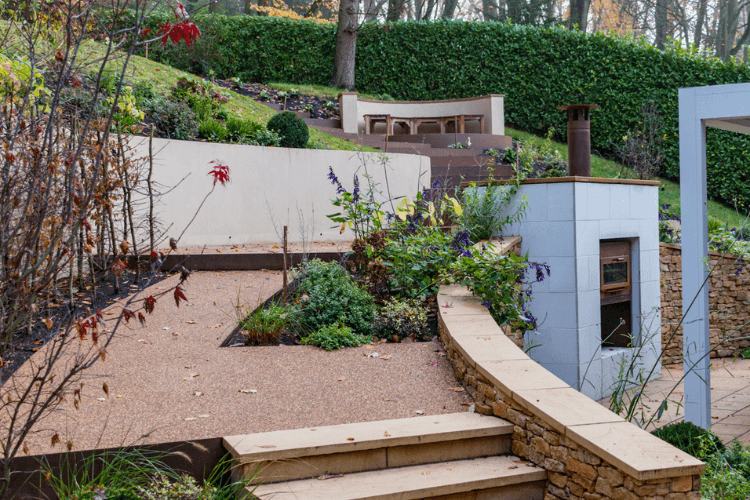Designing Wide but Shallow Gardens: Creating Depth & Space

CEO & Garden Designer
Ruth Marshall

A wide garden with limited depth presents a unique design challenge. Without careful planning, it can feel flat, lacking the inviting sense of progression that a well-balanced landscape should have. You can find yourself staring at a fence rather than a lovely garden, and the space can feel much more cramped than it actually is. At CGLA, we specialise in transforming these spaces, using intelligent design principles and a wealth of creativity to create the illusion of greater depth while enhancing the overall sense of elegance and flow.
Creating the Illusion of Depth
When working with a garden that is wider than it is deep, the key is to draw the eye inwards and create layers of perspective. Simple tricks, such as generous shapes, angled paths, staggered planting, and strategic focal points, help to counteract the dominance of width and lead the gaze further into the space.
- Curved or diagonal pathways guide movement and naturally extend the journey, making the space feel deeper.
- Tiered planting – from structured foreground elements to softer background layers – encourages the eye to move through the garden gradually.
- A focal feature at the furthest point – such as a sculpture, water feature, or striking specimen tree – creates a sense of destination, making the depth feel more substantial.

Zoning Without Overcrowding
In a broad but shallow garden, it’s essential to strike a balance between defined spaces and an uncluttered, flowing layout. Too many sections can make the space feel fragmented, whereas a singular open space may lack interest.

A clever way to break up a wide garden without shortening its perceived depth is to use semi-transparent divisions:
- Open pergolas, slatted screens, or delicate planting layers subtly define different areas without blocking views.
- Gravel or stone transitions between different surfaces (such as lawn to terrace) create a sense of progression without physical barriers.
- Reflective surfaces, such as water features or polished stone, enhance the illusion of space by mirroring light and sky.
Using Verticality to Expand the Space

When depth is limited, height becomes a valuable tool. Well-placed vertical elements draw the eye upwards, shifting the focus away from the shallow dimensions.
- Pleached trees add elegant screening without enclosing the space.
- Tall, narrow planting (such as ornamental grasses or columnar trees) encourages a sense of upward movement rather than horizontal sprawl.
- Trellised walls or green climbers soften boundaries, making them recede rather than feel restrictive.
By extending the gaze skyward, the garden feels grander and more immersive.
Strategic Colour and Texture for Depth
Colour psychology plays a subtle yet powerful role in shaping spatial perception. In a wide but shallow garden, the careful placement of lighter and darker tones can manipulate the sense of depth.
- Lighter shades (soft whites, silvers, pale greens) at the front make a space feel airy and open.
- Darker greens, deep purples, or richer hues towards the rear create a sense of retreat and enclosure, making the back of the garden seem further away.
- A mix of fine and bold textures ensures visual contrast, preventing the garden from feeling flat.
Seamless Integration with Architecture
A wide garden should feel like a natural extension of the home, rather than an expanse beyond it. Thoughtful alignment between indoor and outdoor spaces ensures cohesion:
- Framing key views from interior spaces allows the garden to ‘borrow’ depth from within the house.
- Mirroring architectural elements – such as paving materials or structural lines – connects the garden to its surroundings.
- Continuity in design style ensures the outdoor space complements the property rather than competes with it.
Conclusion
A wide but shallow garden presents a unique design opportunity: rather than being constrained by its proportions, it can be transformed into a layered, dynamic space that feels deeper, richer, and more engaging. By using perspective, vertical elements, and strategic zoning, it’s possible to create an elegant garden that enhances the illusion of space while feeling effortlessly expansive.
At CGLA, we specialise in crafting bespoke landscapes that work with, rather than against, a site’s natural proportions. If you have a wide garden and want to unlock its full potential, we’d love to help bring your vision to life.
CGLA are an award winning team of Garden Designers, Landscape Architects, Landscapers and Garden Maintenance Operatives working in Buckinghamshire, London and the South East, as well as on prestigious design projects across the UK and abroad. We are currently working in Oman, Jersey and France, and welcome enquires for design, landscaping or garden maintenance. Contact us here